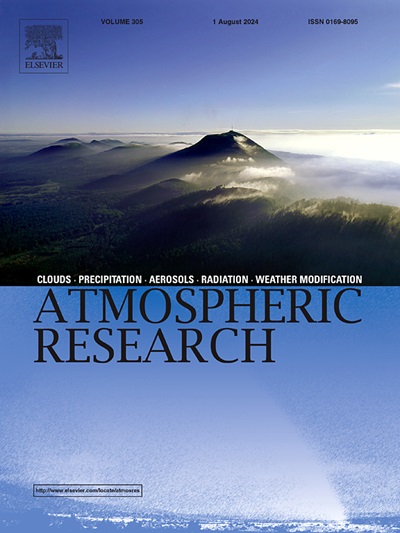Quantifying turbulent coarse particle transport over drylands of Southeastern Iberia using a stand-alone Doppler lidar methodology
IF 4.4
2区 地球科学
Q1 METEOROLOGY & ATMOSPHERIC SCIENCES
引用次数: 0
Abstract
Using a methodology for the estimation of coarse particle exchanges via Doppler lidar, based on the eddy covariance technique, profiles of vertical transport velocities were derived and analyzed. The methodology was tested across diverse atmospheric conditions in two different Mediterranean dryland landscapes in Southeastern Spain, namely Guadiana-UGR (extensive, inland olive grove), and Aguamarga (shrubland with maritime influence). Firstly, study cases were analyzed and the main atmospheric mechanisms impacting particle transport were identified. Convective mixing within the boundary layer was found to be the primary driver of the upward particle transport. However, cloud cover was observed to attenuate the transport velocity, while significant deposition events were observed during a Saharan dust outbreak. Secondly, positive transport velocities were found during convective periods and lower, yet positive, values during non-convective periods. Higher transport velocities were observed during a drier period at Guadiana-UGR, likely due to drier soil conditions. Aguamarga exhibited notably lower transport velocities. Considering only the lowermost observational level (105 m above the ground), net emission of particles was observed. Footprint analysis supported the representativeness of the fluxes. Our findings provide novel insights into particle exchanges over Mediterranean drylands, quantifying the turbulent transport and identifying its atmospheric drivers. Additionally, the considered ecosystems were found to be net sources of particles during the study periods. These results highlight the role of drylands as emerging contributors to global dust emissions in the context of climate change.
使用独立多普勒激光雷达方法量化伊比利亚东南部旱地上的湍流粗颗粒输送
采用基于涡旋相关方差技术的多普勒激光雷达估计粗粒子交换的方法,推导并分析了垂直输运速度剖面。该方法在西班牙东南部两个不同的地中海旱地景观的不同大气条件下进行了测试,即Guadiana-UGR(广泛的内陆橄榄林)和Aguamarga(受海洋影响的灌木丛)。首先,对研究案例进行了分析,确定了影响颗粒输运的主要大气机制。边界层内的对流混合是粒子向上运移的主要驱动因素。然而,观测到云覆盖减弱了输送速度,而在撒哈拉沙尘爆发期间观测到显著的沉积事件。其次,在对流期间发现了正的传输速度,而在非对流期间发现了较小的正值。Guadiana-UGR在干旱时期观测到较高的输送速度,可能是由于土壤条件干燥。阿瓜玛尔加表现出明显较低的传输速度。仅考虑最低观测高度(距地面105 m),观测到颗粒的净排放。足迹分析支持通量的代表性。我们的发现为地中海旱地的颗粒交换提供了新的见解,量化了湍流运输并确定了其大气驱动因素。此外,在研究期间,所考虑的生态系统被发现是颗粒的净来源。这些结果突出了旱地作为气候变化背景下全球粉尘排放的新贡献者的作用。
本文章由计算机程序翻译,如有差异,请以英文原文为准。
求助全文
约1分钟内获得全文
求助全文
来源期刊

Atmospheric Research
地学-气象与大气科学
CiteScore
9.40
自引率
10.90%
发文量
460
审稿时长
47 days
期刊介绍:
The journal publishes scientific papers (research papers, review articles, letters and notes) dealing with the part of the atmosphere where meteorological events occur. Attention is given to all processes extending from the earth surface to the tropopause, but special emphasis continues to be devoted to the physics of clouds, mesoscale meteorology and air pollution, i.e. atmospheric aerosols; microphysical processes; cloud dynamics and thermodynamics; numerical simulation, climatology, climate change and weather modification.
 求助内容:
求助内容: 应助结果提醒方式:
应助结果提醒方式:


